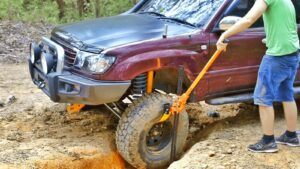Contents
Do I really need a winch for my jeep?
Simply my answer is yes. If you are not keeping your off-roading jeep at home, sure you will need a winch.When off-roading we can’t say what kind of tough situations will be encountered on the trails.
Even a small pit filled with mud would be stuck in your vehicle giving you 5 to 6 hours of exhaustive recovering without a winch. I’ll give you my openion.so that you can decide whether you want a winch or not.
Why do you need a winch on off-roading ?
Due to a tough work schedule on weekdays, Normally I go off-roading 1 or 2 weekends a month now.
Even if that’s the case I’m not thinking twice to attach a winch to my jeep because anything can happen on a trail.
A climate change like rain will influence so much on changing a trail into an extreme trail. Even without a rain on off roads, a few inch deep mud hole or a rut can cause your vehicle to get stuck due to loss of traction.
I faced more than enough those kinds of situations on trails. In those situations my winch saved me from hours of recovery work in minutes.
Still think it’s not necessary ?
I know one of my friends had to do a recovery work of 5 hours bogging on a mud hole, but he wasn’t able to get his jeep out. Then he had to call another friend’s jeep to rescue him.
That rescue jeep went their from his home, only for that recovery purpose.If he had a winch it’s a case of less than 20 minutes.
So that’s how it is.I think it’s a good investment to buy a winch, if you are really going for off-roading. If you are not using your jeep for off-roading purposes then no need of attaching one.
Think about how and where you are going to use your jeep. Then you can decide whether a winch will be useful in your case or not.
But again I’m telling you, if you wish to go tough off roading terrains, don’t think twice to buy a winch.
If you really do off-roading with your jeep winch will save you from a lot of pain. you can go on any off-roading trip with your loved ones with peace of mind.
How the article is going on..
I hope to write this article , breaking it down into 2 articles due to the huge amount of details on winching. So you can skip the subtopics and read what you want to know according to what you are searching for.
If you are completely new to this winching scenario then you can get a whole lot of knowledge from this article series.
In this 1st article you will get the following
What accessories should you need for winching ?
Basic winching techniques
Advanced techniques of winching
How to operate a winch safely and recover a stuck vehicle ?
What accessories should you need for winching ?
- Extension strap
- Tree trunk protector strap
- Two / Three blanckets
- Winch block
- Glouse
- Winch remote
- D rings
- Radios for communication
Above accessories are mainly needed for a basic recovery process. Other than those, in critical situations sometimes two winch blocks and snatch straps are also used.
But those situations are rare in a normal trail. In extreme conditions those kinds of winching techniques are also used.
I.e : double directional pull techniques.
Don’t get confused. NeXT we’ll discuss those techniques in depth.
Basic winching techniques
First we’ll see what are the different setups used in winching.
Rigging (Basic single line pull)
I think you saw this. This is the basic winching technique. when stucked on mud or somewhere, most of the time we use this as in the below diagram.
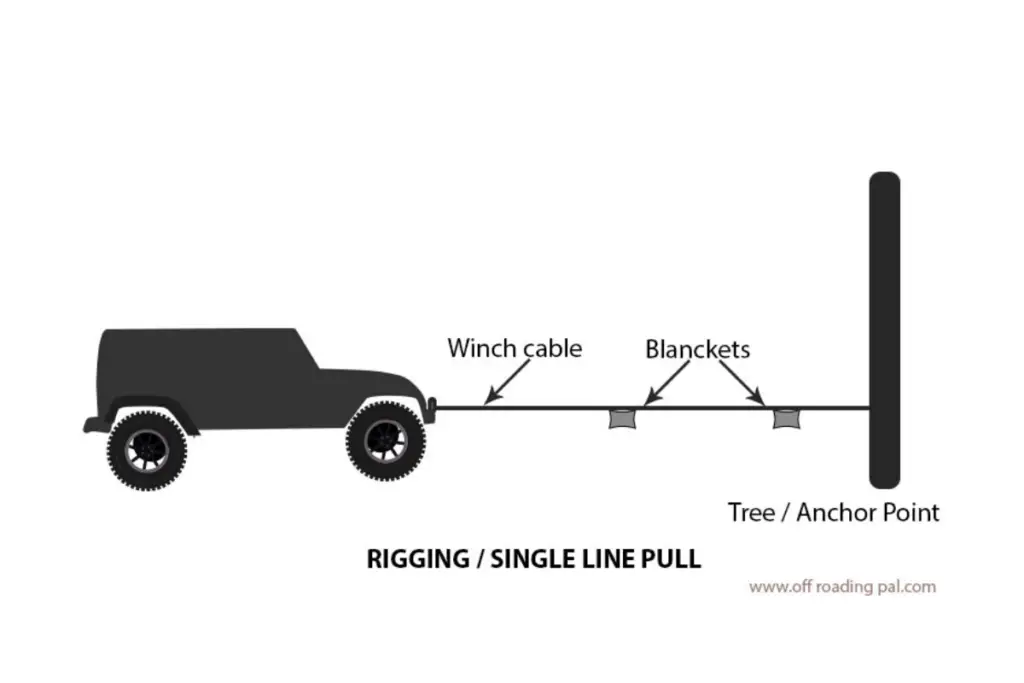
For this first choose a strong tree. Don’t pick dead or internally hollowed trees. If you have a quite big one near luckily good !
Place your tree trunk protector strap around the tree close to the base of the tree (in a normal situation) and attach it with your hook of the winch cable. Straps should not be twisted.
Don’t attach the bow shackles between the hook and tree trunk protector. It means you are adding another metal to fly and cause damages if something went wrong while the system is in tension.
Attach two blankets on the winch cable as shown in the above image. One is in the middle and the other one is near 1 meter to the hook.
Weight of these blankets will give force downwards to the hook and cable.
So if something breaks while winching those metals can fly around and cause injuries to people around or damages to the vehicles.
To avoid these situations blankets are attached.
Single line pull + full extension strap
When the anchor points are far away than the length of the winch cable this setup can be used.
Here we can connect extension straps, tree trunk protector and winch cable along with use of a bow shackle.
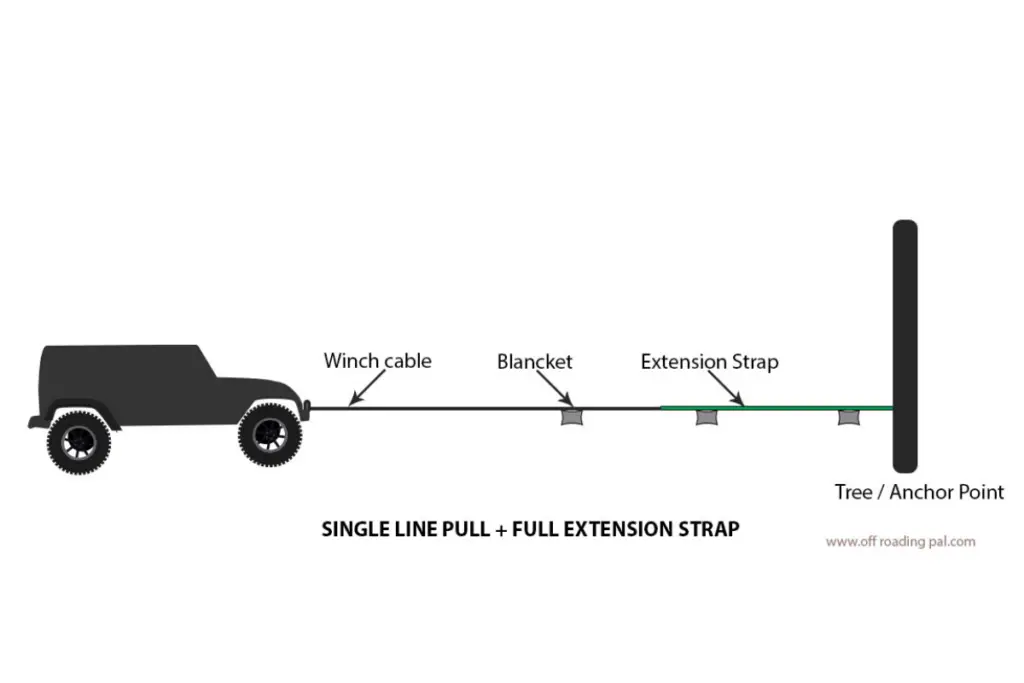
Double line pull
This will increase the strength of the winching and reduce the the speed of winching.when need of a more strength this setup will useful .
Attach the tree trunk protector as in the previous set up.
Then with the help of bow shackles attach the winch block to it and place the cable around the winch block like the below image.
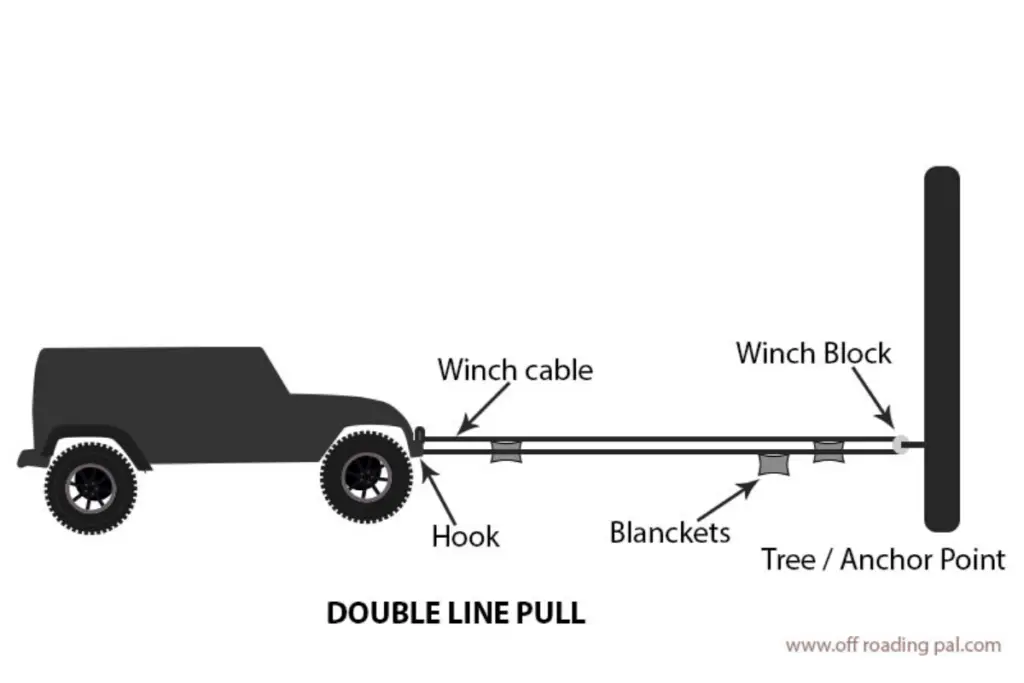
Then the other end of the cable, hook it up to the vehicle.
Then we can attach 3 (or 4) blankets to the cable. One is near to the hook. Other two are attached to the cable near the winch block from the two sides.
When start winching one blanket is moved towards the block while the other is moved towards the winch.
Directional pull
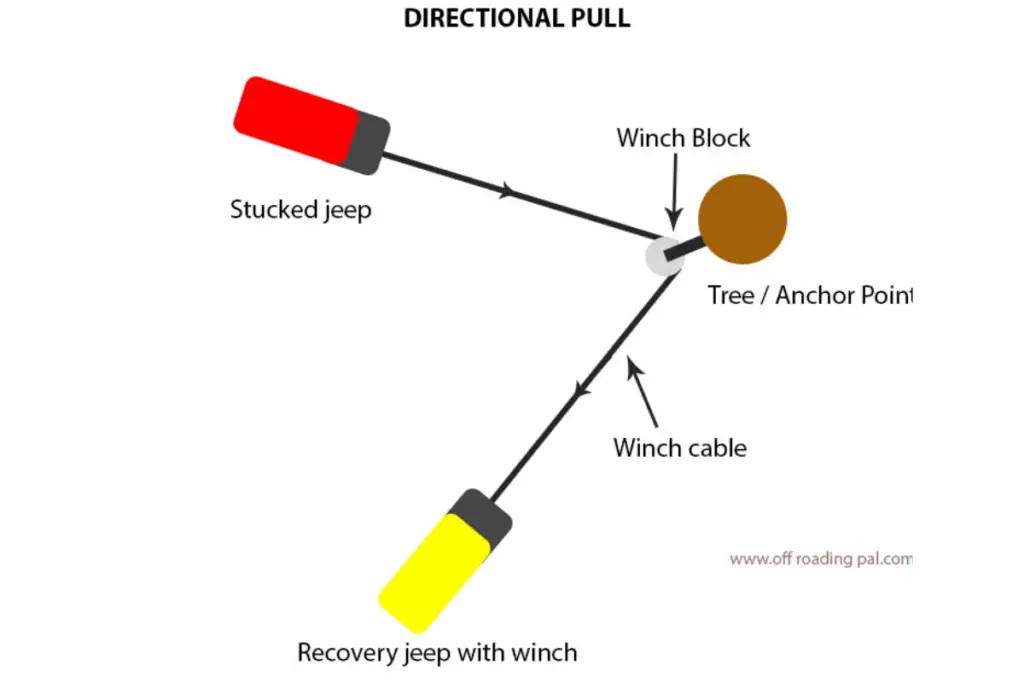
This is sets up when recovering another vehicle , when the recovery vehicle can’t reach or winch directly forward or backward, because of the place where the vehicle is stuck.
The setup is somewhat similar to the double line pull. But here the hook is attaching to the other vehicle. Can attach 3 blankets on the cable.
Winch Block can be attached to a tree or a rated tow point of another vehicle.
Then two vehicles needed for a recovery process other than the stucked vehicle.
These are basic setups which can be used for winching according to different situations occurring on the off-roading trails.
Few advanced techniques of winching
Due to some reasons of the terrain, above winching techniques also may can’t applicable.
Sometimes there may be no proper anchor point near the place stucked.
Due to those kinds of various reasons we have to apply different techniques. Let’s see a few useful techniques.
Double directional winching
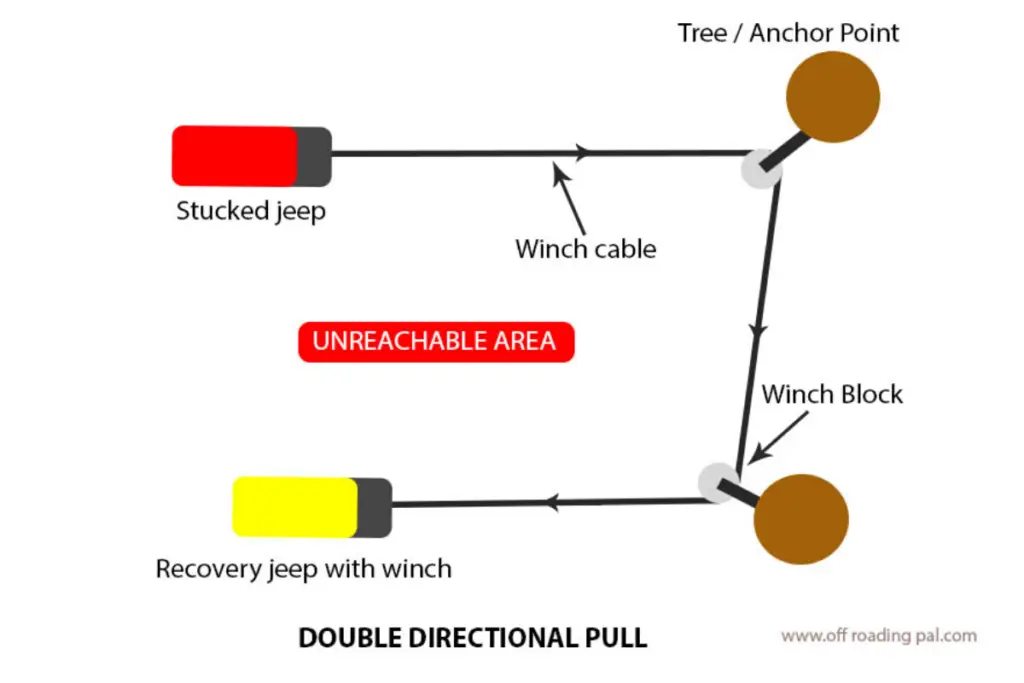
This setup is useful in some instances due to the inability of reaching directly to the stucked vehicle.
Using two winch blocks and two anchor points , winching force can be directed to the stucked vehicle.
Winching on sand
Sand trails are very famous for stucking off-roading jeeps. Without a winch it’s impossible to beat some sand trails if you go alone.
Another main problem we have to face here is that it is hard to find a proper anchor point on sand. Because most of the time there are no suitable trees.
If we have another jeep then it’s not a problem. Then we can even use a snatch strap to get a pull from that vehicle.
But when that option is impossible in some situations, we have to make a temporary anchor point on sand.
For that we can use a few techniques. But normally I think below will be more successful.
Use spare wheel as a anchor point
For this you have to dig a few feet deep pit on sand using shovels.
According to your situation the depth may vary. Normally about 4 feet or 5 feet may be enough.
Then the tree trunk protector strap should attach to your spare wheel and put that into that pit. Make sure to keep the attached surface to the bottom of the pit.
Then attach the winch cable with it and close the pit and tight the sand. Then start winching.
Dead man winching
Here also the same above process is used. But instead of a spear wheel here we used a special blanket as shown in the below video.
Put that into the bottom of the pit and close the pit after getting the 4 straps out of the pit.
Attach the hook up the winch with the straps and start winching.
For the better understanding of this technique you can watch the below video.
With that said I’ll end the techniques section. You can use those set ups according to your needs.
Let’s look at how to perform a winching safely and correctly.
How to operate a winch safely and recover a stuck vehicle ?
- Connect the winch remote control with the winch and release tension off the line to take the hook off from the D ring of the vehicle.
- Then put the winch clutch lever into free spool mode. Then you can freely pull the winch cable out nice and easy to a tree or anchor point.
- Then attach to the recovery point as mentioned in the above rigging section.
- Then you have to start winching. For that you can keep your engine on for charging your battery. Because winch consumes so much power from the battery.keeping on start is not a must.but it’ll be a good practice for some instances.
- Release your parking brakes and gear in neutral position. For this purpose it’s best to have two people.
- One is to operate the winch while the other one is one the driving seat.One who operates the winch should be careful about the connection with anchor points and any abnormality in winch like sounds or movements.
- One who operates the winch should be in safe distance and remove any one who is near the winching cable. Due to high tensions lethal injuries can happen if something goes wrong.
- Put the winch clutch lever back again into the engaged position and wind the cable by hand until the cable lifts from the ground.
- You can use two way radios or hand signals to communicate when performing the winching.
- This way you can winch the vehicle safely as you want.. When doing this, do it while pausing. Don’t try to winch all along the way up at once. Do it slowly and nicely.
- Then put the vehicle in to parking , set emergency braking and release the winch cables tension off the cable and clean up all the rigging.
- Then use your gloves to feed back the line to the spool. Take the line in one hand, remote in the other and just go ahead and winch the rest of the way.
- When doing this work on the winch line back and forth to spool it evenly and spool it under a little bit tension by hand.
- Once you get to the end clip the hook to the d – ring if how it’s placed before.
So those are the things I hoped to discuss for this article. I think you armed with a good knowledge on winching for your next off-roading adventure. See you in the next article.
Have fun and safe off roading pals !!

